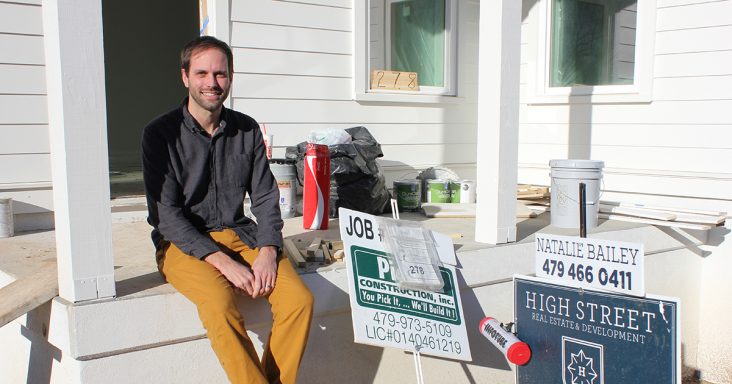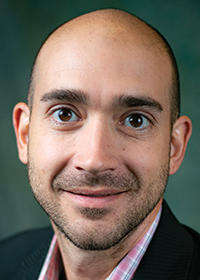Rapid Northwest Arkansas growth leads to higher housing costs
by March 22, 2021 10:54 am 6,129 views

Keaton Smith, board chair for nonprofit developer Partners for Better Housing, would like to see the region collaboratively address the housing affordability issue. Home construction recently started in south Fayetteville at Willow Bend, a mixed-income development of Partners for Better Housing.
Housing affordability is a new challenge for Northwest Arkansas resulting from rapid area growth. The area should work together to address the issue, said Fayetteville bank executive Keaton Smith, board chair for nonprofit developer Partners for Better Housing.
“We’re fortunate to be an incredible place to live, work, play, raise a family, and the word is getting out,” said Smith, who’s a vice president and commercial relationship manager for IberiaBank. “Population growth is a big positive in many ways but also creates some challenges, and housing affordability is a growth-related challenge.”
Smith said most metropolitan areas with 550,000 people have a central city with a housing department that can be a regional convener on affordable housing issues. Northwest Arkansas has built a tradition of working together, but he said the housing issue hasn’t been addressed collaboratively and needs to become a focus for the region.
“Housing is so connected to other regional issues: transportation, land use, education, racial equity, sustainability, workforce development, quality of life and talent retention,” Smith said.
According to housing organizations and reports, housing is considered affordable if it costs less than 30% of a household’s gross income. Habitat for Humanity believes households that spend at least 30% of their income on housing are cost-burdened. Harvard University’s State of the Nation’s Housing 2020 report, sponsored by Habitat for Humanity, shows 37.1 million U.S. households were cost-burdened in 2019. One in seven households, or 17.6 million, was severely cost-burdened or spending at least half their income on housing. Renters struggled more, with 46% cost-burdened compared to 21% of homeowners. Nearly one-fourth of renters and 9% of homeowners were severely cost-burdened.
Brandon Swoboda, executive director for Habitat for Humanity of Washington County, explained the cost tradeoffs low-income families take to make a living.
“If it’s between paying my rent, having to pay childcare and for transportation, and put food on my table, guess what’s not going to happen. I’m not going to have food,” Swoboda said. “I’ve got to pay those other things because I have to have it. And don’t forget about my health insurance, which costs an arm and a leg. Guess what I’m not going to have? Health insurance.”
HIGH HOME VALUES
Meanwhile, the average home price in Northwest Arkansas has risen to new highs and faster than in previous years, according to the most recent Skyline Report. Fayetteville-chartered Arvest Bank sponsors the biannual real estate report completed by the Center for Business and Economic Research (CBER) in the Sam M. Walton College of Business at the University of Arkansas.
The average area home costs $345,765; however, less than 20% of households here can qualify for a mortgage for a home at that price, according to the most recent data from the National Association of Home Builders.
To qualify, households would need to earn at least $74,711, said Tiffany Hudson, executive director for Partners for Better Housing. Of the 299,558 homes in Northwest Arkansas, 59,769 can qualify, the data shows.
“The remaining 239,000 households cannot qualify for a loan at that amount,” Hudson said. “Those households have to rent or search for a less expensive home to purchase.”
Asked what’s making housing affordability a problem in the area, Wes Craiglow, Northwest Arkansas coordinator for Urban Land Institute, pointed to supply and demand. He also noted the lack of a regional unified housing strategy to address the issue.

In the second half of 2020, strong home sales in the area led the supply to fall by 61% to a record low of 707 homes, from 1,812 in the same period in 2019, according to the Skyline Report.
Aaron Wirth, finance chair for the Northwest Arkansas Home Builders Association and co-owner of Cobblestone Homes in Fort Smith, attributed the rising home prices to multiple issues, such as limited lot availability and construction complexities. Another was material costs, especially lumber. According to the National Association of Home Builders, since April 2020, the rise in lumber prices added $24,386 to the cost of an average new home.
Wirth said an advantage of Northwest Arkansas is the good cost of living. He said the region needs to work together to retain it, and housing is significant to it.
CBER director Mervin Jebaraj said Northwest Arkansas has the most expensive housing market in the state. It’s competitive with most metro areas in surrounding states but remains affordable compared to larger metro areas, including Los Angeles, New York and Seattle.
‘CALL TO ACTION’
According to a report sponsored by the Walton Family Foundation, between 25% and 35% of Northwest Arkansas households are housing cost-burdened. In September 2019, the foundation released Our Housing Future: A Call to Action for Northwest Arkansas that shows nearly 80% of extremely and very low-income households were housing cost-burdened. About half of these households are severely cost-burdened.
The report highlights five critical actions for the area to take over the next decade:
- Establish a regional housing compact.
- Create a regional housing trust fund.
- Introduce development incentives to spur participation in regional and local housing initiatives.
- Use publicly owned land for housing production.
- Expand and leverage federal, state and local resources for affordable and workforce housing.

By 2040, Northwest Arkansas would need to add nearly 2,900 homes annually to meet housing demand, the report shows. Over the same period, the region would need more than 18,000 rental units to meet the demand for lower-income households.
Jeremy Pate, senior program officer for the Walton Family Foundation, said the foundation’s 2025 Strategy would address housing affordability. The issue hasn’t reached “a crisis point,” but he said it’s trending in the wrong direction.
“Household income growth is not keeping pace rising rent and homeownership costs, and so we’re trying to find ways that as the region continues to grow, we can ensure that all residents have access to stable and affordable homes,” Pate said. “We’re launching this strategy over the next five years with two primary goals, which is increasing the supply of well-designed affordable housing in mixed-income neighborhoods and enhancing the infrastructure for transportation that supports density. And density supports the transportation infrastructure. Those things are symbiotic in a lot of ways.”
Housing and transportation costs are significant to a region’s overall affordability, and households should not be spending more than 45% on those two costs combined, Pate said.
According to the Center for Neighborhood Technology, the average area household spends 52% on housing and transportation, with one-fourth going to housing.
DEVELOPMENTS UNDERWAY

The Walton Family Foundation, through its Northwest Arkansas Design Excellence Program, supported a project to show how to increase density in a non-controversial way, Pate said. The foundation provided a $120,000 grant to Community Development Corp. of Bentonville/Bella Vista to complete schematic designs for four accessory cottages in downtown Bentonville.
Casey Kleinhenz, executive director for the nonprofit developer, said work recently started on the 0.2-acre Briartown project to build the cottages, ranging from 550 to 900 square feet. Later this year, the developer will release the construction documents and designs to the public. According to the Walton Family Foundation, the goal is to encourage “additional affordable housing development in Bentonville and downtown markets.”
Home construction recently started on a development noted in the foundation’s housing report: mixed-income neighborhood Willow Bend in south Fayetteville, developed by Partners for Better Housing. The $22 million infill development will allow income-qualified buyers to receive a $35,000 discount as part of Arkansas’ first shared equity homeownership program. One-third of the 80 homes in the 9-acre development will be reserved for households who earn up to 80% of the median income for Northwest Arkansas.
